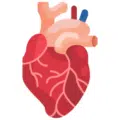Author(s)
Hollie Porras, PharmD
Emily Prohaska, PharmD, BCACP, BCGP
Reviewed By
Debra Barnette, Pharm.D., BCPS, BCACP
Navya Varshney, PharmD
Sara Wettergreen, PharmD, BCACP
Vidán MT, Sánchez FJM, Sánchez E, et al. Most elderly patients hospitalized for heart failure lack the abilities needed to perform the tasks required for self‐care: impact on outcomes. Eur J Heart Fail 2019; 21: 1434-42
The Problem
Heart failure (HF) affects at least 5.7 million people in the United States alone and requires a strict self-care regimen to avoid hospitalizations. HF is a multifaceted disease that disproportionately impacts older adults with a post-hospitalization mortality rate of approximately 20%.1-3 This patient population faces high readmission rates, high medical costs, and many experience a poor quality of life.1-4 But what if patients with HF do not understand or are not capable of carrying out the recommended HF “self-care regimen”? Subjective questionnaires are often used to assess HF symptoms and self-care behaviors but may not accurately depict a patient’s functional capabilities. The FRAIL-HF study attempted to objectively evaluate patients’ ability to perform HF self-care tasks and correlate self-care ability with readmissions rates and one-year mortality.
What’s Known
Recent American College of Cardiology and American Heart Association initiatives strive to educate and motivate patients to learn about HF and to actively participate in their care.5 Only half of older adult patients who visit emergency departments for decompensated HF report independence with activities of daily living.6 Consequently, current research is focusing on improving adherence to guideline-directed therapies and self-care functionality. Despite wide variability in study designs, interventions focused on HF self-care education programs have demonstrated reductions in HF-related hospitalizations and death, but few have assessed actual ability to perform self-care tasks. 7 Insights into self-care ability may be an important aspect in terms of customizing the care of patients with HF as well as overall prognosis.
What’s New
FRAIL-HF, a prospective cohort study, enrolled 450 patients who were at least 70 years of age (mean = 80.1 years) and hospitalized for HF (defined according to the European Society of Cardiology criteria) in a single hospital in Madrid, Spain. Patients were equally divided between females (49.6%) and males. Participants were excluded if unable to perform at least three out of six activities of daily living (bathing, dressing, transferring from a chair, using the toilet, feeding, and grooming), had moderate to severe dementia (defined as Mini-Mental State Examination score < 15), or resided in a nursing home. The primary study objectives were to compare the self-reported vs. actual ability of patients to perform basic tasks for HF self-care at discharge, evaluate patient self-awareness of limitations, as well as to explore the relationship between self-care ability and one-year mortality and readmission risk after discharge. The ability to perform six HF self-care tasks (use a scale, document weight, diuretic identification, knowledge of salted foods, edema identification, and diuretic treatment adjustment) were evaluated. Based on successful independent task completion, subjects were classified as low proficiency (zero or one), moderate proficiency (two or three), or high proficiency (four to six). Patients also completed the European Heart Failure Self-care Behaviour Scale (EHFScBS), which is a validated, self-administered questionnaire that includes 12 questions in the following areas: weight control, HF symptoms and signs identification, low-salted diet, correct treatment, exercise, and influenza vaccination. The scale ranges from 12 to 60, with higher scores indicating poorer self-care knowledge and skill.
Table 1: Ability of FRAIL-HF participants to perform HF self-care tasks (n=415)
|
Task* |
Patients able to perform task independently, n (%) |
|
Diuretic identification |
289 (69.6) |
|
Use of a scale# |
284 (68.4) |
|
Weight registration$ |
191 (46.0) |
|
Salted food identification^ |
187 (45.5) |
|
Edema identification† |
133 (32.0) |
|
Treatment adjustment‡ |
93 (22.4) |
|
All tasks correctly performed |
22 (5.3) |
|
*Tasks defined according to instrumental activities of heart failure self-care criteria #Stand long enough for an accurate weight determination $Accurately read and record the weight ^Identify pictures of high salt foods †Explore edema (or the lack) of their own ankles ‡Accurately state diuretic adjustment based on written provided guidelines |
|
The authors found no significant difference in the average number of HF self-care tasks independently performed when comparing those previously hospitalized to those patients hospitalized for the first time. However, there was a weak positive correlation between the EHFScBS score and actual ability to perform self-care tasks (r Spearman = -0.0135; P = 0.006).
Table 2: Gap between participant’s self-perceived and actual performance
|
Task |
Completely/mostly agree can perform task correctly (%) |
Actual ability to perform task correctly (%) |
Gap (%) |
|
Identify leg edema |
68.1 |
21.5 |
46.6 |
|
Identify diuretic pills |
98.7 |
67.5 |
31.2 |
|
Identify salted foods |
48.7 |
23.4 |
25.3 |
|
Adjust treatment based on 2 kg weight gain |
22.5 |
7.1 |
15.4 |
|
Register weight correctly |
11.3 |
7.5 |
3.8 |
|
Use scale correctly |
11.3 |
9.1 |
2.2 |
kg = kilogram
One-year readmission and mortality rates were correlated with performance proficiency. Notably, there was a significant difference in self-care ability and outcomes between the low, moderate, and high proficiency groups. Patients in the low or moderate proficiency groups were more likely to be older, female, not currently married, and completed less than a high school education.
During the 12-month follow-up period, the mean time to first readmission (for any reason) was 199 + 20 days in the low proficiency group, 193 + 13 days in the moderate proficiency group, and 200 + 14 days in the high proficiency group. 21.1% of the patients died during the follow-up period: 33% in the low proficiency group, 20.7% in the moderate proficiency group, and 14.1% in the high proficiency group (P = 0.002). The mean survival time after discharge was also significantly different in the low, moderate, and high proficiency groups: 290 days, 325 days, and 334 days, respectively (P = 0.002).
The authors concluded that most elderly patients hospitalized for HF are unable to perform several essential HF self-care tasks, their self-perceived ability poorly correlated with actual ability, and poor self-care ability was associated with a higher one-year mortality risk.
Our Critical Appraisal
This study is the first to objectively assess the self-care ability of elderly patients with HF and illustrated that patients inaccurately perceive their own abilities. Self-reported questionnaires, specifically EHFScBS, used to evaluate self-care behaviors correlated poorly with actual functional status. Moreover, this study demonstrated that poor self-care ability is associated with increased mortality in patients with HF after hospital discharge, with significant differences seen in as little as one year of follow up.
Strengths of this study include utilization of the EHFScBS, which is a validated questionnaire widely used to analyze HF self-care behavior.8 The mean subject age slightly greater than 80 years was older than other published HF studies. Additionally, the distribution of patients in low (22.7%), moderate (43.1%), and high (34.2%) proficiency groups demonstrated that more than half of the study participants had notable deficits in actual versus perceived self-care ability. Lastly, the study excluded patients who had significant cognitive or functional impairments. Therefore, the participants are similar to many older adults discharged back to home who are often responsible for performing these HF self-care tasks.
Several limitations need to be considered when analyzing the results of this study. Some exclusion criteria could conversely be viewed as a limitation, as many moderately-to-severely impaired individuals often still reside independently in society. For ethical reasons, patients who were unable to perform HF self-tasks were provided with additional education by the study investigators. Thus, the study may have underestimated the differences in mortality between the proficiency groups. Also, of note, all-cause mortality was assessed, not HF-related mortality. The research was conducted at a single center in Spain and the six specific self-care tasks assessed have not been validated in other patient populations, limiting the study’s generalizability. Lastly, this study did not analyze health-related quality of life, which is a critically important outcome in this population.9,10
The Bottom Line
Poor performance of key HF self-care tasks in older adults was associated with increased mortality risk. Patients frequently overestimated their ability to independently perform HF self-care tasks. Pharmacists can play a vital role in accurately assessing and effectively educating patients regarding HF self-care behaviors, including foods high in sodium, medication review and appropriate use, and adherence to self-monitoring such as measuring weight daily and recording the results in a logbook. Identifying patient-specific self-care limitations as well as developing specific interventions to address them may be critical for providing optimal care for community-dwelling patients with HF.
The Key Points
- Elderly patients with HF are at high risk of hospital readmission and mortality
- Patients’ perceived self-care ability poorly correlated with observed ability
- Most older adults admitted to the hospital for HF are unable to accurately perform key HF self-care tasks and lower performance proficiency was associated with higher one-year mortality
FINAL NOTE: This program will be available for recertification credit through the American Pharmacists Association (APhA) Ambulatory Care Review and Recertification Program. To learn more, visit https://www.pharmacist.com/ambulatory-care-review-and-recertification-activities.
- Dharmarajan K, Hsieh AF, Lin Z, et al. Diagnoses and timing of 30‐day readmissions after hospitalization for heart failure, acute myocardial infarction, or pneumonia. JAMA 2013; 309: 355– 363.
- Cook C, Cole G, Asaria P, Jabbour R, Francis DP. The annual global economic burden of heart failure. Int J Cardiol 2014; 171: 368– 376.
- Bueno H, Ross JS, Wang Y, et al. Trends in length of stay and short‐term outcomes among Medicare patients hospitalized for heart failure, 1993‐2006. JAMA 2010; 303: 2141– 2147.
- Savarese G, Lund LH. Global Public Health Burden of Heart Failure. Card Fail Rev. 2017; 3: 7–11.
- American Heart Association. Target: HF Strategies And Clinical Tools. www.heart.org. https://www.heart.org/en/professional/quality-improvement/target-heart-failure/strategies-and-clinical-tools. Published June 13, 2018. Accessed November 29, 2019.
- Martin-Sanchez FJ, Rodriguez-Adrada E, et al. Impact of frailty and disability on 30-day mortality in older patients with acute heart failure. Am J Cardiol 2017; 120: 1151 – 1157.
- Jonkman NH, Westland H, Groenwold RH, et al. Do Self-Management Interventions Work in Patients With Heart Failure? An Individual Patient Data Meta-Analysis. Circulation. 2016; 133:1189–1198.
- Jaarsma T, Stromberg A, Martensson J, Dracup K. Development and testing of the European Heart Failure Self-care Behaviour Scale. Eur J Heart Fail 2003; 5 :363 – 370.
- Chandra A, Vaduganathan M, Lewis EF, et al. Health-Related Quality of Life in Heart Failure With Preserved Ejection Fraction: The PARAGON-HF Trial. JACC Heart Fail. 2019 ;7: 862-875.
- Khariton Y, Fonarow GC, Arnold SV, et al. Association Between Sacubitril/Valsartan Initiation and Health Status Outcomes in Heart Failure With Reduced Ejection Fraction. JACC Heart Fail. 2019 Sep 7. Pii: S2213-1778(19)30486-X.



 iForumRx.org is a web-based community of practice designed to inform ambulatory care pharmacy specialists, pharmacy residents, and student pharmacists about high-quality, practice-changing evidence.
iForumRx.org is a web-based community of practice designed to inform ambulatory care pharmacy specialists, pharmacy residents, and student pharmacists about high-quality, practice-changing evidence.